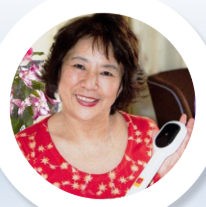Day 1 :
Keynote Forum
Kazuko Tatsumura
Gaia Holistic Health, USA
Keynote: Effects of Far-Infrared & Terahertz Onnetsu Therapy on Various Cancers, Rheumatoid Arthritis and other diseases

Biography:
Kazuko Tatsumura has completed her graduation from Toho Academy of Music in Tokyo, as a Pianist and Composer.
She has invited by the Boston Symphony orchestra. She came to the USA in 1961 as one of the first Japanese
women. She then received Master of Art from New York University and finished her PhD credits in Philosophy in
1965 and another PhD and OMD from the International Academy of Education in Tokyo in 2000. In 1967, she has
turned to an independent career and became the top International Classical and Cultural Impresario/producer. Until
1992, she has conducted an average of 2,000 cultural events per year travelling to more than 140 countries. She
was presented with numerous honors for her work from different countries, many for humanitarian causes. She
has studied Oriental Traditional Medicine of Japan, Korea, Taiwan and China. She established the Oki-Do Holistic
Health Center in 1994 in NY and in 2001 the GAIA Holistic Center (501C3 nonprofit organization) at the wake of
9/11 tragedy, for body mind and spirit, aiming for the noninvasive natural healing methods based on the wisdom of
the East. She has written numerous articles and several books. She is well known as a Philanthropist.
Abstract:
Introduction: Onnetsu means comfortable heat. Onnetsu Therapy invented by Dr. Kazuko
Tatsumura emits from a special patented ceramic; 1) Heat 2) Precise 8-10μ of vibration of
Far Infrared Sunray and 3) Vibration of Terahertz.
Tatsumura is the first in the world to incorporate Terahertz minerals to medical use from
active volcanos stones from Japan. Worldwide patent pending.
Methods: When Onnetsuki is slid over the skin, healthy areas are comfortable, but IF deep
tissue is unhealthy or cold, degenerated, patient feels this spot to be ‘hot’. When this ‘hot
spot’ is effectively treated with Onnetsu Therapy (Far-Infrared & Terahertz vibrations, and
Heat), the hot sensation subsides and the Disease conditions improve through vibrating
water molecules of our deep tissue. Therefore, the Onnetsu Therapy is both a diagnostic
and therapeutic.
Dr Kazuko’s Onnetsu Therapy is based on four historical and scientific facts.
1. Traditional Japanese Concept of the significance of Body Temperature. Hippocrates
also has left quotes on Heat.
2. NASA's finding regarding Far-Infrared vibration from Sun light precise 8-10μ. Also,
added is the specific Terahertz vibration of earth minerals from volcanos stones from
the depth of our planet earth.
3. Immunology by Dr. Toru Abo, balancing autonomic nervous system to improve
condition of white cells; Raising Immunity.
4. Promoting four flows of Energy throughout our body by using acupuncture meridian
technique.
Result: Some countries (Peru, Cuba & Mexico) are practicing it in the hospitals and clinics.
Clinical trials have shown improvements on many diseases: such as asthma, brain, ear & eye
problems, cancers, diabetes, rheumatoid arthritis, tuberculosis and various pain conditions.
Clinical studies from Cuba and Peru will be presented.
Conclusion: Onnetsu Therapy is a new, easy & non-invasive treatment modality to treat
difficult chronic medical conditions. Therapy uses Universal Vibrations, Heat, Light,
Autonomic Nervous System Balance and Acupuncture Meridian System.
Dr. Kazuko has taught Onnetsu Therapy to MDs and health practitioners over past decades
throughout the world.
Keynote Forum
Indira Poola
Silbiotech Inc., USA
Keynote: Breast hyperplasias, risk signature and Breast Cancer

Biography:
Indira Poola has completed her PhD in Biochemistry from Mysore University, Mysore, India and post-doctral training
at the University of Michigan and Cornell University in the USA. She served as a Professor in Biochemistry and
Molecular Biology and Surgery at Howard University Medical School, Washington, D.C. USA for 17 years. She
is currently President of Silbiotech, Inc, in Gaithersburg, MD, USA. She has won 27 grant awards from 9 funding
agencies totalling over $8Million. She has published more than 40 papers in highly reputed journals and has served
as an adhoc reviewer for 24 journals. She has served as an adhoc grant reviewer for 10 different agencies including
NIH, DoD, NSF, EPA, and Komen for the Cure.
Abstract:
Numerous clinical studies have established that diagnosis of hyperplastic masses
increases the cancer risk by 2-5 fold. Clinical follow-up surveys have shown that ~20%
and 10% of subjects diagnosed with atypical and non-atypical hyperpalsias respectively
develop cancer subsequently and are the most suitable candidates for preventative therapies.
However, there are no methods for identifying the above high risk subjects who will most
likely develop future cancers and benefit from prophylactic measures. Due to lack of any
risk stratification tools, healthcare providers as well as patients are faced with a dilemma in
undertaking preventative measures. Our study purpose is to investigate a four marker risk
signature, MMP-1, CEACAM6, HYAL1 and HEC1, using 440 hyperplastic tissues with up
to 19 years of clinical follow-up information for risk stratification and identifying high risk
subjects who will benefit from preventative therapies. We have assayed the marker levels in
the hyperplasia tissues and combined their expression levels to obtain a composite value
from 0-10 which we called a ‘Cancer Risk Score’. We demonstrate that the four marker
based risk scores predict subsequent cancer development with an accuracy of 91% and
86% for atypical and non-atypical subjects respectively. We have established a correlation
between risk scores and cancer rates at 5 years, 10 years and beyond by stratifying the
samples into Low (Score < 0.5), Intermediate (Score <= 5.4) and High (Score > 5.4) risk
groups and Kaplan Meier survival analysis. Our results show that the cancer rates in the
first five years among the low-, and intermediate risk groups were 2%, and 15% respectively
among atypical as well as non-atypical subjects. In the high risk group, the cancer rates
were 73% and 34% for atypical and non-atypical subjects respectively. The molecular risk
stratification developed by us assesses a patient’s tumor biology based risk level in terms of
a cancer risk score and categorizes the patient as low-, intermediate- or high risk for making
informed treatment decisions (Figure 1). The outcomes of our study in conjunction with
the already available prophylactic measures could prevent ~20%-25% of sporadic breast
cancers (Grant Support: National Cancer Institute, National Institutes of Health (CA173919
and CA206774) and the National Science Foundation (IIP-1314287) awarded to I. Poola)..
Keynote Forum
Kazuko Tatsumura
Gaia Holistic Health, USA
Keynote: Effects of Far-Infrared & Terahertz Onnetsu Therapy on Various Cancers, Rheumatoid Arthritis and other diseases

Biography:
Kazuko Tatsumura has completed her graduation from Toho Academy of Music in Tokyo, as a Pianist and Composer.
She has invited by the Boston Symphony orchestra. She came to the USA in 1961 as one of the first Japanese
women. She then received Master of Art from New York University and finished her PhD credits in Philosophy in
1965 and another PhD and OMD from the International Academy of Education in Tokyo in 2000. In 1967, she has
turned to an independent career and became the top International Classical and Cultural Impresario/producer. Until
1992, she has conducted an average of 2,000 cultural events per year travelling to more than 140 countries. She
was presented with numerous honors for her work from different countries, many for humanitarian causes. She
has studied Oriental Traditional Medicine of Japan, Korea, Taiwan and China. She established the Oki-Do Holistic
Health Center in 1994 in NY and in 2001 the GAIA Holistic Center (501C3 nonprofit organization) at the wake of
9/11 tragedy, for body mind and spirit, aiming for the noninvasive natural healing methods based on the wisdom of
the East. She has written numerous articles and several books. She is well known as a Philanthropist.
Abstract:
Introduction: Onnetsu means comfortable heat. Onnetsu Therapy invented by Dr. Kazuko
Tatsumura emits from a special patented ceramic; 1) Heat 2) Precise 8-10μ of vibration of
Far Infrared Sunray and 3) Vibration of Terahertz.
Tatsumura is the first in the world to incorporate Terahertz minerals to medical use from
active volcanos stones from Japan. Worldwide patent pending.
Methods: When Onnetsuki is slid over the skin, healthy areas are comfortable, but IF deep
tissue is unhealthy or cold, degenerated, patient feels this spot to be ‘hot’. When this ‘hot
spot’ is effectively treated with Onnetsu Therapy (Far-Infrared & Terahertz vibrations, and
Heat), the hot sensation subsides and the Disease conditions improve through vibrating
water molecules of our deep tissue. Therefore, the Onnetsu Therapy is both a diagnostic
and therapeutic.
Dr Kazuko’s Onnetsu Therapy is based on four historical and scientific facts.
1. Traditional Japanese Concept of the significance of Body Temperature. Hippocrates
also has left quotes on Heat.
2. NASA's finding regarding Far-Infrared vibration from Sun light precise 8-10μ. Also,
added is the specific Terahertz vibration of earth minerals from volcanos stones from
the depth of our planet earth.
3. Immunology by Dr. Toru Abo, balancing autonomic nervous system to improve
condition of white cells; Raising Immunity.
4. Promoting four flows of Energy throughout our body by using acupuncture meridian
technique.
Result: Some countries (Peru, Cuba & Mexico) are practicing it in the hospitals and clinics.
Clinical trials have shown improvements on many diseases: such as asthma, brain, ear & eye
problems, cancers, diabetes, rheumatoid arthritis, tuberculosis and various pain conditions.
Clinical studies from Cuba and Peru will be presented.
Conclusion: Onnetsu Therapy is a new, easy & non-invasive treatment modality to treat
difficult chronic medical conditions. Therapy uses Universal Vibrations, Heat, Light,
Autonomic Nervous System Balance and Acupuncture Meridian System.
Dr. Kazuko has taught Onnetsu Therapy to MDs and health practitioners over past decades
throughout the world.
Keynote Forum
Keson Trakunram
Prince of Songkla University, Thailand
Keynote: Up-regulation of serum mir-339-3p as a diagnostic Biomarker for non-small cell lung cancers

Biography:
Keson Trakunram received her both Bachelor’s (Biotechnology) and Master’s (Pharmacology) degrees form
Faculty of Science, Prince of Songkla University (PSU). Presently, she is a philosophy student at Department
of Biomedical Sciences, Faculty of Medicine, PSU. According to her thesis, she is interested in microRNAs
expression leading to diagnostic biomarkers in lung cancer. Major scope of her study focuses on serum
microRNA profiling using microarray and bioinformatics tools. Moreover, she has published about two papers
and one international proceeding.
Abstract:
MicroRNAs (miRNAs), small non-coding RNA, play important role as negative
regulation of gene expression. Deregulation of miRNAs has been used for
predicting cancer progression in various cancers, including non-small cell lung cancer
(NSCLC). Therefore, searching for potential non-invasive biomarkers is need for rapid
diagnosis of lung cancer. This study aimed to evaluate whether serum miR-339-3p can
be a diagnostic biomarker for NSCLC. A retrospective study was designed. Serum was
collected from 151 suspected patients with lung cancer. All patients were diagnosed at
Songklanagarind Hospital (Hat Yai, Thailand), a university hospital in Southern Thailand,
between December 2017 and September 2018. Expression of miR-339-3p was determined
by quantitative real-time PCR (qRT-PCR) technique. Receiver operating characteristic
(ROC) curve and the area under the curve (AUC) were used to test the diagnostic
performance. Result showed that 66 patients were NSCLC and 85 patients were non-
NSCLC. The mean relative expression of serum miR-339-3p in NSCLC patients was
approximately two times higher compared with that of non-NSCLC patients with P-value
of 0.009. In addition, the ROC curve data indicated that this serum miR-339-3p can
distinguish the NSCLC patients from the non-NSCLC patients with the AUC of 0.624
(95% CI: 0.53-0.71). The sensitivity was 73% and the specificity was 45%. In conclusion,
serum miR-339-3p may serve as a circulating biomarker for diagnosis of lung cancer.
Keynote Forum
Aylin Erol
Dokuz Eylul University, Turkey
Keynote: Sesquiterpene lactones as a candidate anti-cancer agent in childhood cancer

Biography:
Aylin Erol has completed her MSc from Basic Oncology at Dokuz Eylul University, Turkey. Currently, she is
pursuing her PhD at the Dokuz Eylul University. She has published four papers with the project group and
also, had one oral presentation. Her work focuses specifically on the anti-cancer natural products for pediatric
cancers.
Abstract:
Despite improvements in treatment of pediatric cancers, new treatment strategies are
needed. Sesquiterpene lactones (SL) are natural compounds with proofs of anti-
cancer effects in adults. The effect of SL on pediatric cancers remains unclear. The aim of
this study is to evaluate the in vitro effects of dehydroleucodine (DhL) and Inula viscosa
extracts (containing high levels of active SL) in pediatric cancers. Inula viscosa plant
extract (InV), DhL (sigma) and cisplatin (Kocak) (CDDP) were evaluated on various
pediatric cell lines. Neuroblastoma cell line KELLY, Ewing sarcoma cell line SK-ES
and hepatocellular carcinoma cell line Hep-G2 were cultured. After treating with these
chemical compounds, MTT cell viability assay, Annexin V+PI test by flow cytometry
were performed. Morphological changes of cells were investigated using Toluidine blue
staining. Immunohistochemistry was performed to determine proliferation index (Ki67)
and apoptosis mechanisms (Caspase 3, 8 and 9). The statistical analysis of all findings
was evaluated between and within groups by Mann-Whitney U test. The p value less than
0.05 were considered statistically significant. In Kelly, DhL and InV showed cytotoxic
effect as CDDP. The underlying mechanism of this effect was on inducing apoptosis
rather than anti-proliferation. In HEP-G2; CDDP, InV, and DhL decreased proliferation,
led to apoptosis especially via intrinsic pathway. For SK-ES; DhL and InV showed less
anti-proliferative effect than CDDP. However, remarkable apoptosis percentiles were
found in cells. According to the results of this in vitro study, InV, and DhL are found to
be candidate anti-cancer agent on pediatric cancer cells with their cytotoxic effects. This
effect is planned to be evaluated in further studies.
Keynote Forum
Rim Bouchelaghem
Badji Mokhtar University, Algeria
Keynote: Apelin-13 inhibits the antiproliferative AMP-activated kinase in MCF-7 breast cancer cell line

Biography:
Rim Bouchelaghem is pursuing her PhD in Biochemistry and Environmental Toxicology Laboratory at University
Badji Mokhtar in Annaba (UBMA), Algeria. Her research concentrates on the discovery of biomarkers in breast
cancer. She has completed her Doctoral degree in Medicine from UBMA, and her MSc degree in Immunology
from University de Sherbrooke (UdeS), Canada. She is working on Molecular Analysis at the anatomo-
pathology section of the Anti-Cancer Center (CAC) Abdelaziz Al Saoud of Annaba.
Abstract:
Breast cancer is considered the leading cause of death for women worldwide.
Currently, the characterization of biomarkers for subtypes of breast cancer is an
urgent requirement that makes it possible to better optimize the consensus of diagnosis
and treatment of this disease in more homogeneous subgroups. Pre-clinical exploratory
studies to identify potential candidates as tumor biomarkers are considered the first
step to refine the research of such molecules. Many members of the G protein-coupled
receptors family (GPCRs) are known for their implication in breast cancer progression
and metastasis. In our study, we aim to verify the role of intracellular signaling induced
by Apelin peptide jejunum (APJ), a GPCR, as a new modulator of growth signaling in the
breast cancer cell line, MCF-7. We confirmed for the first time the constitutive expression
of the APJ receptor in MCF-7 by two different techniques, immunocytochemistry, and
confocal microscopy. Also, we explored the effect of APJ activation by its specific ligand,
apelin-13, on the AMP-activated protein kinase (AMPK), which is known in the literature
for its antiproliferative effect on MCF-7 cell line. MCF-7 cells were treated for 5, 10, 20,
30 or 60 minutes with 100 nM apelin-13, in the presence or the absence of 1 nM estrogen.
We verified by immunoblotting that apelin-13 decreases the constitutive AMPK activity
in a time-dependent manner. Our results confirm that, the activation of APJ in MCF-7
by apelin-13 and suggest a proliferative role of this hormone, at least by the abrogation
of the AMPK signaling pathway. Our study will provide a new trail in the understanding
of the molecular mechanisms involved in breast carcinogenesis, a prerequisite for the
development of targeted therapies against this complex disease.
Keynote Forum
Workinesh Daba Seboka
Addis Ababa University, Ethiopia
Keynote: Coping strategies of women with breast cancer seeking care at Black Lion Hospital, Department of Oncology, Addis Ababa, Ethiopia

Biography:
Workinesh Daba Seboka has completed her BSc degree from School of Nursing and Midwifery, Addis Ababa
University and Master of Public Health in Reproductive and Family Health from School of Public Health, Addis
Ababa University. She is a Lecturer at Addis Ababa University - College of Health Sciences, School of Nursing
and Midwifery. She has six years of work experience and an expert Midwife Professional.
Abstract:
Background: A diagnosis of breast cancer regardless of the stage can be stressful, impact
multiple spheres of life, and disrupt physical status, emotional and spiritual well-being,
and personal relationships for the patient and family. In order to adapt, the patient ought
to employ certain coping mechanisms.
Objectives: The objective of the study is to assess the coping strategies of women with
breast cancer in Black Lion Hospital, Oncology Department.
Methods: An institutional cross sectional survey was employed to collect data on coping
strategies of women with breast cancer seeking care at Black Lion Hospital, Oncology
Department, Addis Ababa, Ethiopia from March to April, 2016. A structured interviewer
administered questionnaire was used to collect information from study participants. The
data collection process was guided by an interviewer to gather information from the study
participants. Data coding, entry and cleaning was accomplished using EpiData3.1 after
which it was exported to SPSS version 23 for analysis.
Results: The results of this study showed the most commonly used coping strategies
among women with breast cancer seeking care at Black Lion Hospital were self-distraction,
planning, behavioural disengagement, and religion. It was found that coping with breast
cancer was significantly associated with age less than 49 years which is five times more
likely than with age greater than 50 years (AOR=4.582; CI=95%: 1.532-13.699). Married
women were four times more likely to cope with breast cancer compared to unmarried
women (AOR=3.601; CI=95%: 1.434-9.044). Being educated secondary school and
above is associated four times more likely to cope with breast cancer than illiterates.
Conclusion: A diagnosis of breast cancer causes stress to the patients. Predominant
coping strategies used were: self-distraction; planning; behavioural disengagement; and
religion. The strategy employed influences adaptation to the diagnosis.
